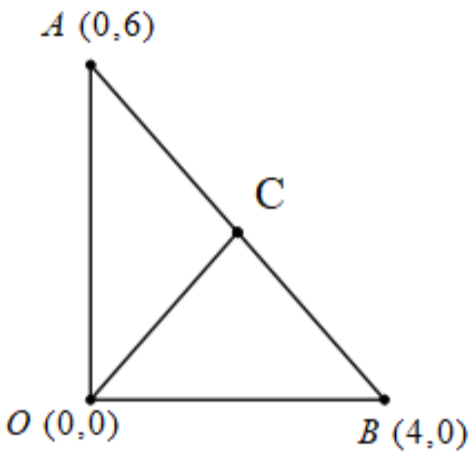Answer
438.9k+ views
Hint: In order to solve this problem, we need to find the value of the coordinates of point C. We can find the coordinates of the midpoint of any segment by using the midpoint formula. It is given as follows, $\text{Midpoint}=\left( \dfrac{{{x}_{1}}+{{x}_{2}}}{2},\dfrac{{{y}_{1}}+{{y}_{2}}}{2} \right)$ , where ${{x}_{1}},{{x}_{2}}$ are x coordinates and ${{y}_{1}},{{y}_{2}}$ are the y coordinates. Also, we need to know the distance formula which is given as follows, $\text{Distance}=\sqrt{{{\left( {{x}_{2}}-{{x}_{1}} \right)}^{2}}+{{\left( {{y}_{2}}-{{y}_{1}} \right)}^{2}}}$ .
Complete step-by-step solution:
To understand the question better we need to draw the diagram.

We are given that C is the midpoint of the segment AB. And we need to show that C is equidistant from all the vertices of $\Delta OAB$.
The vertices of the $\Delta OAB$ are points O, A, and B.
Then we need to show that OA = OB = OC
For finding the distance we need to find the coordinates of C.
We know that C is the midpoint of segment AB.
The formula for the midpoint is $\left( \dfrac{{{x}_{1}}+{{x}_{2}}}{2},\dfrac{{{y}_{1}}+{{y}_{2}}}{2} \right)$ .
Where ${{x}_{1}},{{x}_{2}}$ are x coordinate and ${{y}_{1}},{{y}_{2}}$ are the y coordinates.
Substituting the values we get,
Point C = $\left( \dfrac{0+4}{2},\dfrac{6+0}{2} \right)=\left( 2,3 \right)$
Now we have the coordinates of all the four points.
The formula for distance between two points is given as follows,
$\text{Distance}=\sqrt{{{\left( {{x}_{2}}-{{x}_{1}} \right)}^{2}}+{{\left( {{y}_{2}}-{{y}_{1}} \right)}^{2}}}$ , where ${{x}_{1}},{{x}_{2}}$ are x coordinate and ${{y}_{1}},{{y}_{2}}$ are the y coordinates.
Now let's first calculate the distance of segment CA.
Substituting the values of x coordinates and y coordinates we get,
$CA=\sqrt{{{\left( 2-0 \right)}^{2}}+{{\left( 3-6 \right)}^{2}}}$
Solving this equation, we get,
$\begin{align}
& CA=\sqrt{4+{{\left( -3 \right)}^{2}}} \\
& =\sqrt{4+9} \\
& =\sqrt{13}
\end{align}$
Now let’s find the distance of segment CB.
Substituting the values of x coordinates and y coordinates we get,
$CB=\sqrt{{{\left( 2-4 \right)}^{2}}+{{\left( 3-0 \right)}^{2}}}$
Solving this equation, we get,
$\begin{align}
& CA=\sqrt{{{\left( -2 \right)}^{2}}+{{\left( 3 \right)}^{2}}} \\
& =\sqrt{4+9} \\
& =\sqrt{13}
\end{align}$
Now let’s find the distance of segment CO.
Substituting the values of x coordinates and y coordinates we get,
$CO=\sqrt{{{\left( 2-0 \right)}^{2}}+{{\left( 3-0 \right)}^{2}}}$
Solving this equation, we get,
$\begin{align}
& CO=\sqrt{4+9} \\
& =\sqrt{13}
\end{align}$
We can see that the distance between CA = CB = CO.
Hence, we can say that C is equidistant from all the vertices of $\Delta OAB$.
Note: In this problem, we need to use the distance formula. We can assign any value as ${{x}_{1}}$ and ${{x}_{2}}$ as we are going to square that number anyways. But we need to be careful that whenever we assign an x coordinate as ${{x}_{1}}$ we need to assign the same point as ${{y}_{1}}$. A similar process can be applied for finding the midpoint.
Complete step-by-step solution:
To understand the question better we need to draw the diagram.

We are given that C is the midpoint of the segment AB. And we need to show that C is equidistant from all the vertices of $\Delta OAB$.
The vertices of the $\Delta OAB$ are points O, A, and B.
Then we need to show that OA = OB = OC
For finding the distance we need to find the coordinates of C.
We know that C is the midpoint of segment AB.
The formula for the midpoint is $\left( \dfrac{{{x}_{1}}+{{x}_{2}}}{2},\dfrac{{{y}_{1}}+{{y}_{2}}}{2} \right)$ .
Where ${{x}_{1}},{{x}_{2}}$ are x coordinate and ${{y}_{1}},{{y}_{2}}$ are the y coordinates.
Substituting the values we get,
Point C = $\left( \dfrac{0+4}{2},\dfrac{6+0}{2} \right)=\left( 2,3 \right)$
Now we have the coordinates of all the four points.
The formula for distance between two points is given as follows,
$\text{Distance}=\sqrt{{{\left( {{x}_{2}}-{{x}_{1}} \right)}^{2}}+{{\left( {{y}_{2}}-{{y}_{1}} \right)}^{2}}}$ , where ${{x}_{1}},{{x}_{2}}$ are x coordinate and ${{y}_{1}},{{y}_{2}}$ are the y coordinates.
Now let's first calculate the distance of segment CA.
Substituting the values of x coordinates and y coordinates we get,
$CA=\sqrt{{{\left( 2-0 \right)}^{2}}+{{\left( 3-6 \right)}^{2}}}$
Solving this equation, we get,
$\begin{align}
& CA=\sqrt{4+{{\left( -3 \right)}^{2}}} \\
& =\sqrt{4+9} \\
& =\sqrt{13}
\end{align}$
Now let’s find the distance of segment CB.
Substituting the values of x coordinates and y coordinates we get,
$CB=\sqrt{{{\left( 2-4 \right)}^{2}}+{{\left( 3-0 \right)}^{2}}}$
Solving this equation, we get,
$\begin{align}
& CA=\sqrt{{{\left( -2 \right)}^{2}}+{{\left( 3 \right)}^{2}}} \\
& =\sqrt{4+9} \\
& =\sqrt{13}
\end{align}$
Now let’s find the distance of segment CO.
Substituting the values of x coordinates and y coordinates we get,
$CO=\sqrt{{{\left( 2-0 \right)}^{2}}+{{\left( 3-0 \right)}^{2}}}$
Solving this equation, we get,
$\begin{align}
& CO=\sqrt{4+9} \\
& =\sqrt{13}
\end{align}$
We can see that the distance between CA = CB = CO.
Hence, we can say that C is equidistant from all the vertices of $\Delta OAB$.
Note: In this problem, we need to use the distance formula. We can assign any value as ${{x}_{1}}$ and ${{x}_{2}}$ as we are going to square that number anyways. But we need to be careful that whenever we assign an x coordinate as ${{x}_{1}}$ we need to assign the same point as ${{y}_{1}}$. A similar process can be applied for finding the midpoint.
Recently Updated Pages
Mark and label the given geoinformation on the outline class 11 social science CBSE

When people say No pun intended what does that mea class 8 english CBSE

Name the states which share their boundary with Indias class 9 social science CBSE

Give an account of the Northern Plains of India class 9 social science CBSE

Change the following sentences into negative and interrogative class 10 english CBSE

Advantages and disadvantages of science

Trending doubts
Which are the Top 10 Largest Countries of the World?

Difference between Prokaryotic cell and Eukaryotic class 11 biology CBSE

Differentiate between homogeneous and heterogeneous class 12 chemistry CBSE

10 examples of evaporation in daily life with explanations

Fill the blanks with the suitable prepositions 1 The class 9 english CBSE

How do you graph the function fx 4x class 9 maths CBSE

The Equation xxx + 2 is Satisfied when x is Equal to Class 10 Maths

Difference Between Plant Cell and Animal Cell

What are the monomers and polymers of carbohydrate class 12 chemistry CBSE



